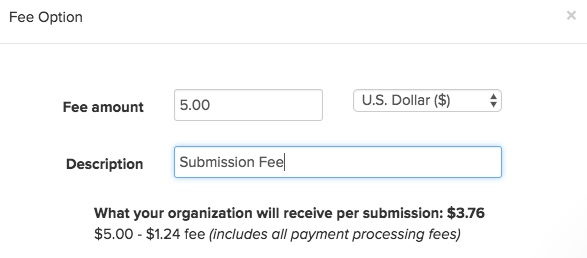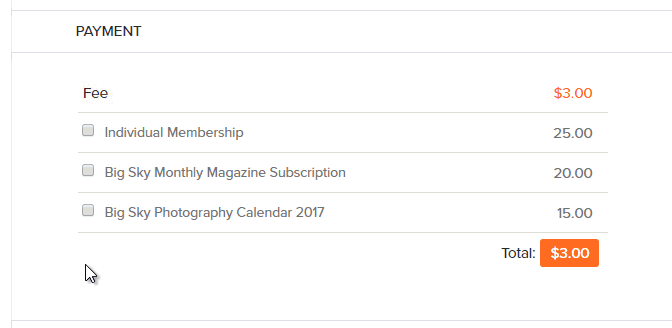Many organizations that rely on Submittable for their submission or application process also take advantage of the software’s integrated payment features. Whether you’re interested in charging a per-application fee, collecting class registrations, facilitating an awards process, or using the platform to sell merchandise, Submittable is built to assist.
How it works
There are two ways to collect revenue during the submission or application process: required fees and Add-on Payments. For both processes, Submittable offers built-in payment processing, and submitters have the option of paying via credit card, debit card, or PayPal.
Submittable charges .99 cents + 5% of the total fee (minimum $2) for each submission. Of that fee, 4% goes towards Submittable’s payment processing costs and the remainder supports security measures and the staff time required to facilitate refunds on behalf of organizations.
If a required fee is included in your form, submitters or applicants need to finalize payment before completing their submission.
Add-on Payments are optional charges that a submitter can either choose to include in their submission or bypass.
Both options are available in the Form Builder’s General Settings tab. Submittable can process submission fees in non-U.S. currency and refunds are quickly issued by our support team at the organization’s request.
Fee types
Organizations utilize Submittable’s payment processing features for a wide variety of fee types. Some are directly linked to the submission or application process and others relate to services, products, and programming offered by the organization.
Whereas other software may require organizations to integrate their own payment processing, like Stripe, or collect payment for only certain types of transactions, Submittable’s flexibility enables our clients to get creative with revenue generation. Here are 14 of the most common ways organizations use Submittable to collect fees.
For Submissions and Applications
1. Flat fee
This fee type is the most common, wherein each submission or application requires the same flat fee in exchange for review by the organization. This fee can range widely depending on the type of submission, from $3 for a poetry submission to a literary magazine to $100 for a professional award submission, for which the winner receives a large cash prize.
2. “Tip jar” fee
A “tip jar” fee functions like a donation option and can be used in a variety of ways. Most organizations offer this either as an ongoing option for generous submitters (in addition to free submissions) or a fee option when they reach their plan’s free submission cap.
3. Feedback Fee
When an organization is willing to offer comments and critiques on an application or submission, they will often include this in the submission price to compensate for the time required.
4. Expedited Submission Fee
If a submitter or applicant is anxious to receive a quicker response, some organizations will allow them to submit at a higher price point for expedited review.
5. Time-Sensitive Fee
In this case, an organization may offer tiered early-bird pricing up to a certain date, regular pricing beyond that, and even a late option at an increased rate. Many film festivals currently use this type of structure.
6. Scaled Fee
This fee type depends on the quantity of material the application or submitter is sending in. For example, some galleries will charge a certain rate to consider a single photograph, a different rate for three photos, and a scaled rate for up to seven photos.
7. Submission Fee with Merchandise
A submission or application may automatically come with, for example, the last book released by a press or a tote bag.
8. Combination Fee
Organizations may combine any of the above options to generate revenue. For example, they might offer an applicant feedback, a subscription, and also an expedited response in the same submission form.
For Services, Donations, Merchandise, and Opportunities
9. Consultation
With this type of fee, the submission or application is not being considered for acceptance. Rather, the charge is exclusively dedicated to comprehensive feedback (digital, in-person, or both), often used by presses for book manuscripts.
10. Donation
Some organizations will collect donations apart from the submission process, as either an add-on payment or as a distinct submission form.
11. Retail Purchase
Clients may choose to sell products, services, or merchandise independent from their submission forms. The most common examples include membership and subscriptions but clients also market everything from collector’s items and t-shirts to anthologies and artwork.
12. Educational Opportunity
Some organizations offer special opportunities like certification programs, classes, and workshops that require either an application fee to be considered, a registration fee to enroll, or both.
13. Fellowship and Residency Application Fee
Many arts organizations use Submittable not only to review content but also to facilitate fellowship and residency programs, most of which are accompanied by an application review fee.
14. Retreat
Similar to fellowships and residencies but with a generally lower barrier for entry, organizations collect registration fees (including food and lodging costs) for retreats (often in creative fields) using Submittable.
**
Clients across a wide range of industries appreciate the convenience of Submittable’s integrated payment system and the variety of ways they can put it to use. Please be in touch anytime if you’d like to explore how Submittable software can serve your organization or if we can assist you in setting up forms with required fees or Add-on Payments.

